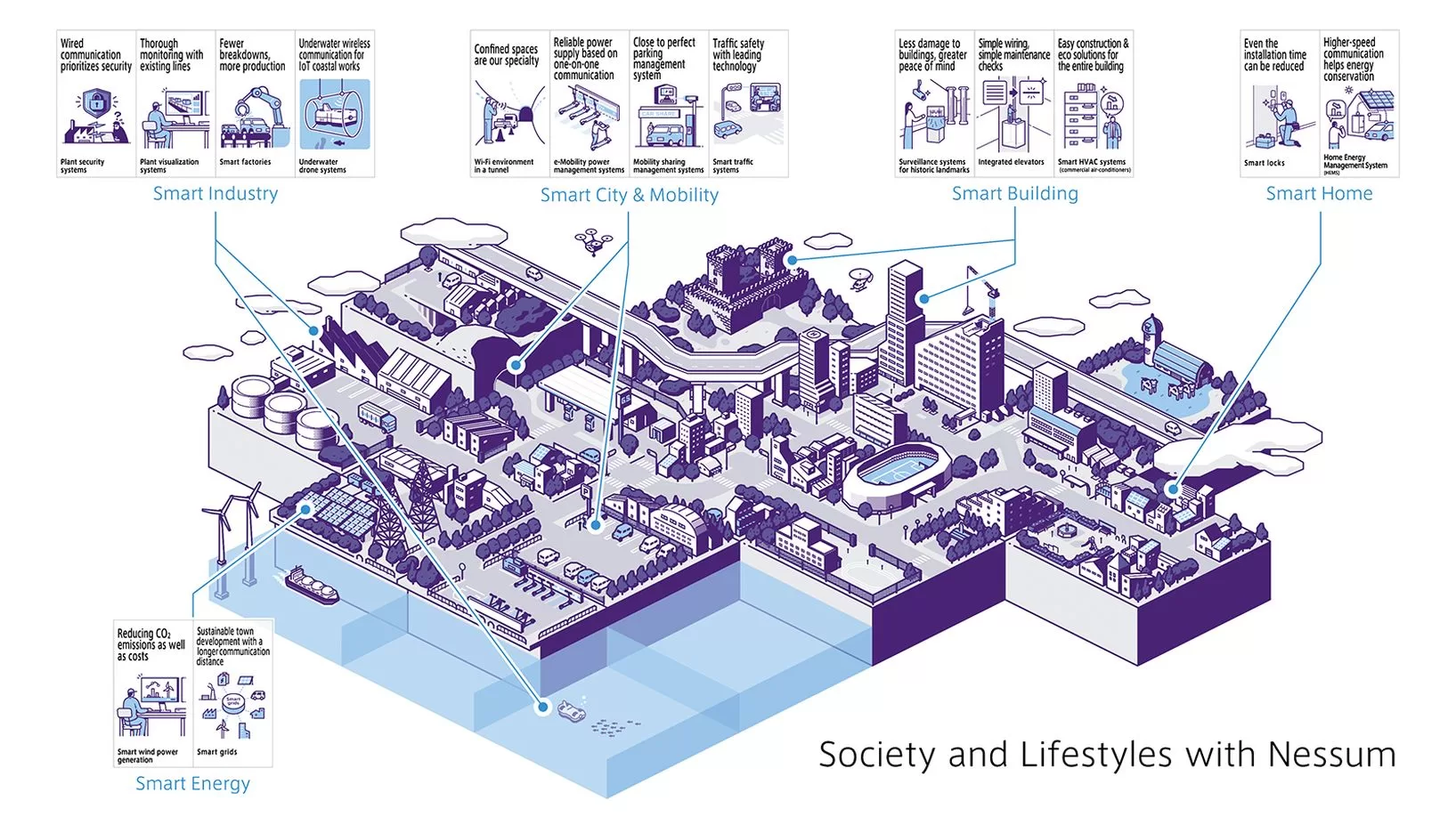
Panasonic Holdings Corporation (PHD) has developed a technology that enables communication over multiple mediums based on the Wavelet orthogonal frequency division multiplexing*2 (OFDM) method and after recent deliberation, the Institute of Electrical and Electronics Engineers (IEEE) Standards Association*3 Board of Directors approved this technology as the new IEEE 1901c*4 standard. This standard allows the same modulation and demodulation method to be used in a variety of communication mediums (including wired, wireless, and underwater)*5 and is intended to contribute as one of the communication means to bring about an IoT society. By licensing semiconductor IP cores that comply with this standard to semiconductor companies, PHD aims to accelerate the dissemination and deployment of semiconductor IP cores in the global market.
PHD changed the brand name of this technology from “HD-PLC”*6 to “Nessum” in September 2023. Based on the newly-approved communication standards, this technology will first extend the frequency used for wired communication from the conventional megahertz band to the kilohertz band, enabling further long-distance communication in communication mediums. By using general metal wiring such as power lines and communication lines, long-distance communication covering several kilometers, Mbps-class broadband communication, Internet Protocol (IP) support, topology-free, flexible network configurations, and safe and secure communication functions are made possible.
In addition, by applying this technology to wireless communication using weak radio waves using antennas, it is possible to achieve short-range high-speed wireless*7 communication that can limit the communication range.
By applying this technology to wireless communications, it will also contribute to the enabling of IoT communication in the sea, which had been considered difficult in the past*8. The application of this technology to undersea and underwater IoT has been adopted by the National Institute of Information and Communications Technology (NICT) as part of the Beyond 5G R&D promotion project “R&D of wireless communication technology for undersea and underwater IoT” (Adoption No. 02301)*9 and demonstration experiments are being conducted along with technology development.
Europe and Asia have already begun to adopt Nessum technology for smart grid and smart energy communication infrastructure, especially air conditioning equipment and building control equipment for large-scale facilities such as large buildings and factories. It is also expected to contribute to reducing the cost of introducing IoT devices. The newly-approved IEEE 1901c enhances the basic performance of the conventional Nessum and its functions to expand the scope of use. PHD is designing and developing semiconductor IP cores in parallel with the standardization work, and with the approval of the IEEE, the company will start licensing them to semiconductor companies and utilize them in Panasonic Group’s products and services.
In addition, the company will work with the Nessum Alliance*10 and member companies to verify interconnection and promote dissemination.

Notes:
*1: “Nessum” and its logo are trademarks of Panasonic Holdings Corporation in Japan and other countries.
*2: Wavelet OFDM: The term “wavelet” refers to the function of a localized wave (a wave of finite length that rapidly decays) and is used for frequency analysis by applying wavelet transformation to the data. A type of discrete wavelet conversion is utilized in OFDM to achieve this technology.
*3: The standards committee that formulates communication standards under IEEE (the Institute of Electrical and Electronics Engineers)
*4: A communication specification that was deliberated and formulated as part of a project approved and established by the IEEE Standard Institute in May 2022
https://standards.ieee.org/ieee/1901c/10922/
*5: The world's first communications technology and international standard that enables wired (using power lines or control lines), wireless, and undersea communications using a common modulation and demodulation scheme.
*6: HD-PLC is the name of a high-speed power line communication format proposed by the Panasonic Group and is a registered trademark or trademark in Japan and other countries. PLC is the initialism for Power Line Communication.
*7: Near-field, high-speed communication technology based on Wavelet OFDM was released as PaWalet Link technology on November 10, 2021.
https://news.panasonic.com/global/press/en211110-2
*8: Wireless optical communication and wireless acoustic communication were conventionally developed as undersea IoT communication technologies. Although wireless optical communication enables high-speed communication, problems are encountered if used in light-absorbing environments such as the deep sea. On the other hand, while wireless acoustic communication enables long-distance transmission, it tends to be slow.
*9: Undersea IoT communication technology is a technical theme promoted by the National Institute of Information and Communications Technology (NICT)'s Beyond 5G R&D Promotion Project and is being jointly developed with the Kyushu Institute of Technology.
https://www.nict.go.jp/collabo/commission/B5Gsokushin/B5G_02301.html
*10: An organization that supplemented the former HD-PLC Alliance on November 1, 2023 with the aim of expanding the spread of Nessum, ensuring communication compatibility, and international standardization activities.
https://nessum.org/




